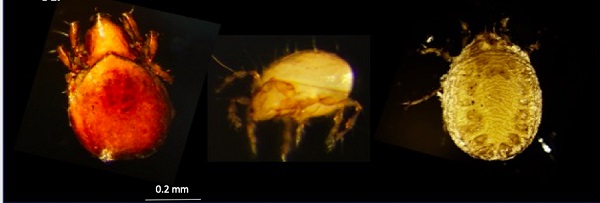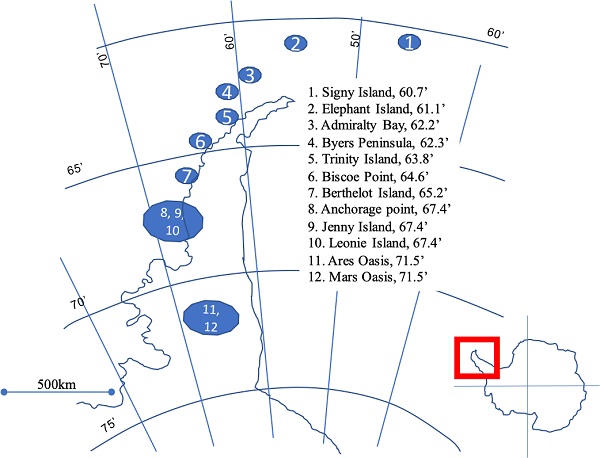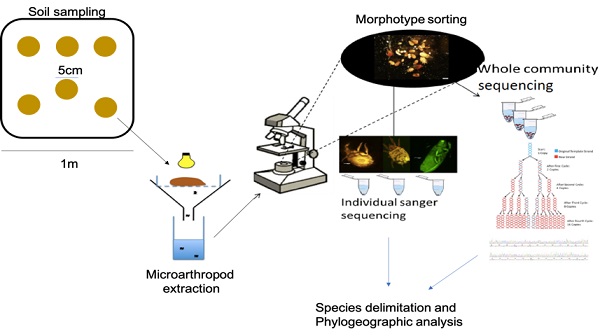Doctor Giles Ross
Candidature
Graduated PhD 2024
Thesis Title
Phylogeographic Analysis of Antarctic Soil Invertebrates
Research summary
 Antarctica’s terrestrial ecosystems are populated by diverse yet understudied invertebrate communities, essential for healthy ecosystem functioning. My project aims to expand our knowledge of their distribution and response to environmental change. Mite, springtail and nematode samples collected from the islands off the Antarctic Peninsula along a 10º latitudinal transect will be analysed using comparative phylogeography to discern evolutionary histories of the endemic fauna. Contemporary distribution patterns are highly influenced by climatic changes that have occurred since the end of the Last Glacial Maximum (LGM) that led to melting ice-sheets and rising sea-levels. To determine the principle factors shaping soil invertebrate communities, temperate Australian ecosystems with similar dispersal limitations are compared with the Antarctic communities. Biogeographic events that enable dating of isolation periods can improve the timing of speciation events and generating dispersal models for specific invertebrate groups. By studying Antarctic fauna using a combination of approaches, I hope to reveal the fundamental drivers of their distribution at the a) local scale; environmental and biotic variables, b) regional scale; climatic influences and gene flow; and, c) temporal scale; evolution and dispersal. This project will contribute towards establishing baseline biodiversity for these vital ecosystem operators, and advance our ability to manage invertebrate biodiversity under accelerating environmental change.
Antarctica’s terrestrial ecosystems are populated by diverse yet understudied invertebrate communities, essential for healthy ecosystem functioning. My project aims to expand our knowledge of their distribution and response to environmental change. Mite, springtail and nematode samples collected from the islands off the Antarctic Peninsula along a 10º latitudinal transect will be analysed using comparative phylogeography to discern evolutionary histories of the endemic fauna. Contemporary distribution patterns are highly influenced by climatic changes that have occurred since the end of the Last Glacial Maximum (LGM) that led to melting ice-sheets and rising sea-levels. To determine the principle factors shaping soil invertebrate communities, temperate Australian ecosystems with similar dispersal limitations are compared with the Antarctic communities. Biogeographic events that enable dating of isolation periods can improve the timing of speciation events and generating dispersal models for specific invertebrate groups. By studying Antarctic fauna using a combination of approaches, I hope to reveal the fundamental drivers of their distribution at the a) local scale; environmental and biotic variables, b) regional scale; climatic influences and gene flow; and, c) temporal scale; evolution and dispersal. This project will contribute towards establishing baseline biodiversity for these vital ecosystem operators, and advance our ability to manage invertebrate biodiversity under accelerating environmental change.
Research images
3 x Oribatid mite morphotypes

Antarctic Peninsula sample sites

Invertebrate sample workflow from soil sampling to sequence analysis

Publications
Ross GM, Rymer PD, Cook JM, Nielsen UN, (2025) 'Phylogeography of Antarctic soil invertebrate fauna reveals ancient origins, repeated colonization and recent evolution', Antarctic Science, vol.37, no.1, pp 13-30
Potapov AM, Chen T-W, Striuchkova AV, Alatalo JM, Alexandre D, Arbea J, Ashton T, Ashwood F, Babenko AB, Bandyopadhyaya I, Baretta CRDM, Baretta D, Barnes AD, Bellini BC, Bendjaballah M, Berg MP, Bernava V, Bokhorst S, Bokova AI, Bolger T, Bouchard M, Brito RA, Buchori D, Castaño-Meneses G, Chauvat M, Chomel M, Chow Y, Chown SL, Classen AT, Cortet J, Čuchta P, de la Pedrosa AM, De Lima ECA, Deharveng LE, Doblas Miranda E, Drescher J, Eisenhauer N, Ellers J, Ferlian O, Ferreira SSD, Ferreira AS, Fiera C, Filser J, Franken O, Fujii S, Koudji EG, Gao M, Gendreau-Berthiaume B, Gers C, Greve M, Hamra-Kroua S, Handa IT, Hasegawa M, Heiniger C, Hishi T, Holmstrup M, Homet P, Høye TT, Ivask M, Jacques B, Janion-Scheepers C, Jochum M, Joimel S, Jorge BCS, Juceviča E, Kapinga EM, Kováč Ľ, Krab EJ, Krogh PH, Kuu A, Kuznetsova N, Lam WN, Lin D, Lindo Z, Liu AWP, Lu J-Z, Luciáñez MJ, Marx MT, Mawan A, McCary MA, Minor MA, Mitchell GI, Moreno D, Nakamori T, Negri I, Nielsen UN, Ochoa-Hueso R, Oliveira Filho LCI, Palacios-Vargas JG, Pollierer MM, Ponge J-F, Potapov MB, Querner P, Rai B, Raschmanová N, Rashid MI, Raymond-Léonard LJ, Reis AS, Ross GM, Rousseau L, Russell DJ, Saifutdinov RA, Salmon S, Santonja M, Saraeva AK, Sayer EJ, Scheunemann N, Scholz C, Seeber J, Shaw P, Shveenkova YB, Slade EM, Stebaeva S, Sterzynska M, Sun X, Susanti WI, Taskaeva AA, Tay LS, Thakur MP, Treasure AM, Tsiafouli M, Twala MN, Uvarov AV, Venier LA, Widenfalk LA, Widyastuti R, Winck B, Winkler D, Wu D, Xie Z, Yin R, Zampaulo RA, Zeppelini D, Zhang B, Zoughailech A, Ashford O, Klauberg-Filho O, Scheu S, (2024) 'Global fine-resolution data on springtail abundance and community structure', Scientific Data, vol.11, no.1, Article no.22
Ross GM, Berg MP, Salmon S, Nielsen UN, (2022) 'Phylogenies of traits and functions in soil invertebrate assemblages', Austral Ecology, vol.47, no.3, pp 465-481
Ross GM, Horn S, Macdonald CA, Powell JR, Reynolds JK, Ryan MM, Cook JM, Nielsen UN, (2020) 'Metabarcoding mites: Three years of elevated CO2 has no effect on oribatid assemblages in a Eucalyptus woodland', Pedobiologia, vol.81-82, Article no.150667
Supervisors
A/Professor Uffe Nielsen, Dr Paul Rymer, Professor James Cook
and
Candidature
Graduated Master of Philosophy (2018)
Thesis Title
Impacts of elevated CO2 and ecosystem restoration on belowground biodiversity in Cumberland Plain Woodlands
Project description
 Land-use intensification and climate change are the two most pressing challenges caused by human actions to which ecosystems must adapt, in order to remain sustainable in the long-term. These two global change agents reduce the above and belowground biodiversity of terrestrial ecosystems, and influences critical ecosystem functioning essential for ecosystem stability. Assessing how biodiversity recovers following these impacts, can help shape strategies for managing ecosystems such as the endangered Cumberland Plain Woodlands (CPW). In this project I aim to quantify belowground biodiversity responses to elevated atmospheric carbon dioxide concentration using the Eucalyptus Free Air CO2 Enrichment (EucFACE) facility, and to further assess whether restoration of CPW increases belowground biodiversity and ecosystem functioning.
Land-use intensification and climate change are the two most pressing challenges caused by human actions to which ecosystems must adapt, in order to remain sustainable in the long-term. These two global change agents reduce the above and belowground biodiversity of terrestrial ecosystems, and influences critical ecosystem functioning essential for ecosystem stability. Assessing how biodiversity recovers following these impacts, can help shape strategies for managing ecosystems such as the endangered Cumberland Plain Woodlands (CPW). In this project I aim to quantify belowground biodiversity responses to elevated atmospheric carbon dioxide concentration using the Eucalyptus Free Air CO2 Enrichment (EucFACE) facility, and to further assess whether restoration of CPW increases belowground biodiversity and ecosystem functioning.
Belowground soil invertebrates and microarthropods play a key role in soil carbon (C) and nutrient cycling due to their role in leaf litter decomposition and organic matter dynamics through direct and indirect effects (i.e. as microbial grazers, predators, etc.). Oribatid mites will be used as indicators of belowground biodiversity responses to eCO2 and restoration because of their ubiquity, species diversity and sensitivity to soil disturbance through land-use. Using a combination of morphological sorting and molecular metabarcoding techniques, it is possible to acquire reliable measures of mite species compositions (presence/absence) and community abundances, by simultaneously sequencing the mitochondrial "barcode" COI region from multiple specimens. This will allow me to rapidly assess oribatid mite biodiversity and relate this to microbial community composition and ecological functioning. This project will help develop a protocol for metabarcoding analysis of soil faunal assemblages, which can then be applied more broadly.
Research Supervisors
Dr Uffe Nielsen and Professor James Cook